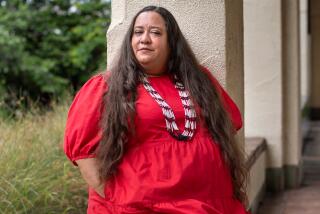Preserving Local History
- Share via
It might be hard to imagine today, but the Sunland-Tujunga area was once a popular vacation spot, which offered fancy resorts and scenic landscapes.
Years ago, it was among the favorite spots for Los Angeles residents to relax and get away from hectic city life. The area was also known for its olive groves, where olive oil was sold.
Of course, that was in the 1920s, and the area has changed so much it’s difficult to imagine what it once was like.
Nowadays, Sunland and Tujunga are working-class neighborhoods best known because their names appear on signs on the 210 Freeway. And there seems to be little reason for folks who don’t live in the area to stop there.
But here’s a reason, especially for those who want to reminisce about the good old days: Bolton Hall Museum in Tujunga.
It’s a rock structure built in 1913 in what was then called Los Terrenitos (Little Lands). A man named George Harris built the place using rocks gathered from local hillsides and Tujunga Wash.
Today, the structure definitely looks out of place among the neighborhood’s run-down apartment buildings and small warehouses.
Fortunately, it’s protected from urban destruction and decay, thanks to a 1962 resolution that declared Bolton Hall a historical monument.
Inside, visitors can gain a sense of history about the area. There’s a sewing machine from the early 1900s, a large chest from 1920 and some of the simple equipment used to build the house--an old wheelbarrow with rusty tools in it.
“Those are the actual things they used to build this place,” said docent Evelyn Burdge, a Tujunga resident since 1937. “Incredible, isn’t it?”
The spacious main room has shiny hardwood floors and a huge rock fireplace in the center. The room is lined with a series of glass cases featuring different exhibits.
The first has baskets, marine fossils and tools used by the Gabrielino Indians who once lived in the area. There are arrow points and scrapers as well as decorative baskets.
Another exhibit offers a history of Tujunga. There’s the land grant the Lopez brothers received in 1840, the original record of land transfer from 1845, old maps and a variety of photos illustrating the area’s different stages of growth.
There is even a bottle of California olive oil from 1923 and a great black-and-white photo taken in 1916 of Bolton Hall and the surrounding land covered in snow.
“The area has changed so much,” Burdge said. “I remember when we used to have our own water company in Tujunga. In 1947, we had to turn to city water because there were too many people in the area.”
The museum also has a temporary exhibit through August that features literature with ties to the area. Among the more prominently displayed authors is Steven McGroarty, playwright, columnist, lawyer, U.S. representative and California Poet Laureate. McGroarty, whose “Mission Play” made him a popular playwright in 1911, is considered the area’s most famous resident because for years he lived on a small hacienda, called Rancho Chupa Rosa, near Tujunga.
Next to his work and photo are books by local residents as well as a script, “Long Way Back,” also written by a local, that was made into a movie.
Also displayed are original items used inside the house in the 1920s. Among them is a pot-belly stove, a coal container and lanterns. Docents explain how the items were used.
“I remember as a little girl, we used those to heat the house because there was no gas or electricity,” Burdge said. “When kids visit us, they just get a kick out of it.”
* Send Jaunts ideas, allowing at least two weeks’ notice, to staff writer Irene Garcia at The Times, 20000 Prairie St., Chatsworth 91311. Or send e-mail to Irene.Garcia@latimes.com.
BE THERE
Tours--Learn about the vast history of the Sunland-Tujunga area at Bolton Hall Museum, 10110 Commerce Ave., Tujunga. Exhibits feature Gabrielino Indians, the area’s olive farms and well-known authors such as Steven McGroarty. Museum is open Tuesdays and Sundays, 1-4 p.m., but tours are available other days by appointment. Admission is free. Information: (818) 352-1718.
More to Read
Sign up for The Wild
We’ll help you find the best places to hike, bike and run, as well as the perfect silent spots for meditation and yoga.
You may occasionally receive promotional content from the Los Angeles Times.






